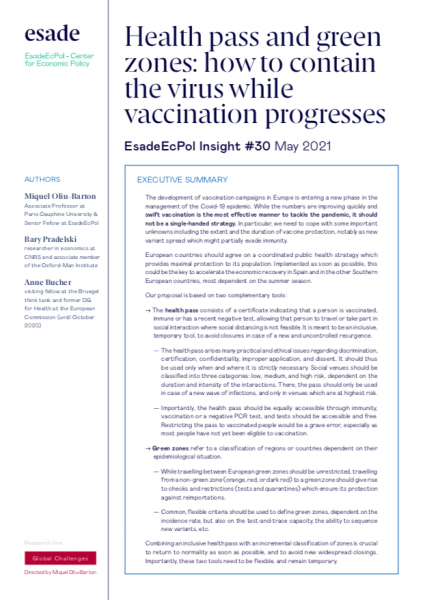
Health pass and green zones: how to contain the virus while vaccination progresses
Miquel Oliu-Barton, Bary Pradelski, Anne Bucher
26 May, 2021
The development of vaccination campaigns in Europe is entering a new phase in the management of the Covid-19 epidemic. While the numbers are improving quickly and swift vaccination is the most effective manner to tackle the pandemic, it should not be a single-handed strategy. In particular, we need to cope with some important unknowns including the extent and the duration of vaccine protection, notably as new variant spread which might partially evade immunity.
European countries should agree on a coordinated public health strategy which provides maximal protection to its population. Implemented as soon as possible, this could be the key to accelerate the economic recovery in Spain and in the other Southern European countries, most dependent on the summer season.
Our proposal is based on two complementary tools:
The health pass consists of a certificate indicating that a person is vaccinated, immune or has a recent negative test, allowing that person to travel or take part in social interaction where social distancing is not feasible. It is meant to be an inclusive, temporary tool, to avoid closures in case of a new and uncontrolled resurgence.
- The health pass arises many practical and ethical issues regarding discrimination, certification, confidentiality, improper application, and dissent. It should thus be used only when and where it is strictly necessary. Social venues should be classified into three categories: low, medium, and high risk, dependent on the duration and intensity of the interactions. There, the pass should only be used in case of a new wave of infections, and only in venues which are at highest risk.
- Importantly, the health pass should be equally accessible through immunity, vaccination or a negative PCR test, and tests should be accessible and free. Restricting the pass to vaccinated people would be a grave error, especially as most people have not yet been eligible to vaccination.
Green zones refer to a classification of regions or countries dependent on their epidemiological situation.
- While travelling between European green zones should be unrestricted, travelling from a non-green zone (orange, red, or dark red) to a green zone should give rise to checks and restrictions (tests and quarantines) which ensure its protection against reimportations.
- Common, flexible criteria should be used to define green zones, dependent on the incidence rate, but also on the test-and-trace capacity, the ability to sequence new variants, etc.
Combining an inclusive health pass with an incremental classification of zones is crucial to return to normality as soon as possible, and to avoid new widespread closings. Importantly, these two tools need to be flexible, and remain temporary.


Associate professor of economics at CNRS and an associate member of Oxford-Man Institute
View profile
Visiting fellow at the Bruegel think tank and former DG for Health at the European Commission
View profile


